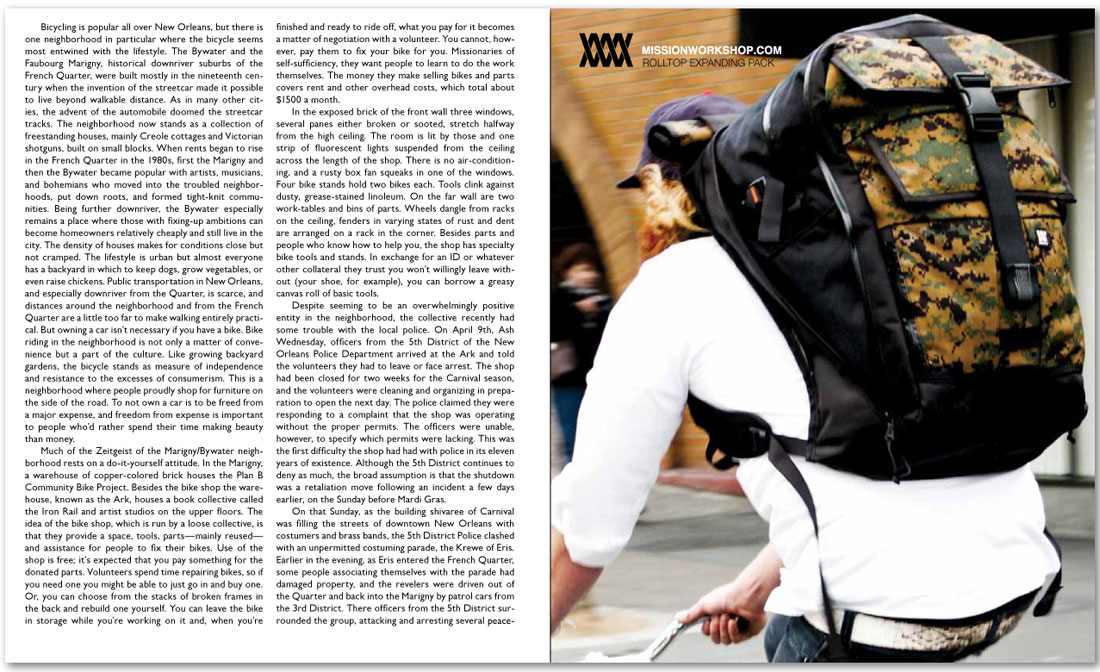


Bicycling is popular all over New Orleans, but there is one neighborhood in particular where the bicycle seems most entwined with the lifestyle. The Bywater and the Faubourg Marigny, historical downriver suburbs of the French Quarter, were built mostly in the nineteenth century when the invention of the streetcar made it possible to live beyond walkable distance. As in many other cities, the advent of the automobile doomed the streetcar tracks. The neighborhood now stands as a collection of freestanding houses, mainly Creole cottages and Victorian shotguns, built on small blocks. When rents began to rise in the French Quarter in the 1980s, first the Marigny and then the Bywater became popular with artists, musicians, and bohemians who moved into the troubled neighborhoods, put down roots, and formed tight-knit communities. Being further downriver, the Bywater especially remains a place where those with fixing-up ambitions can become homeowners relatively cheaply and still live in the city. The density of houses makes for conditions close but not cramped. The lifestyle is urban but almost everyone has a backyard in which to keep dogs, grow vegetables, or even raise chickens. Public transportation in New Orleans, and especially downriver from the Quarter, is scarce, and distances around the neighborhood and from the French Quarter are a little too far to make walking entirely practical. But owning a car isn’t necessary if you have a bike. Bike riding in the neighborhood is not only a matter of convenience but a part of the culture. Like growing backyard gardens, the bicycle stands as measure of independence and resistance to the excesses of consumerism. This is a neighborhood where people proudly shop for furniture on the side of the road. To not own a car is to be freed from a major expense, and freedom from expense is important to people who’d rather spend their time making beauty than money.
Much of the Zeitgeist of the Marigny/Bywater neighborhood rests on a do-it-yourself attitude. In the Marigny, a warehouse of copper-colored brick houses the Plan B Community Bike Project. Besides the bike shop the warehouse, known as the Ark, houses a book collective called the Iron Rail and artist studios on the upper floors. The idea of the bike shop, which is run by a loose collective, is that they provide a space, tools, parts—mainly reused—and assistance for people to fix their bikes. Use of the shop is free; it’s expected that you pay something for the donated parts. Volunteers spend time repairing bikes, so if you need one you might be able to just go in and buy one. Or, you can choose from the stacks of broken frames in the back and rebuild one yourself. You can leave the bike in storage while you’re working on it and, when you’re finished and ready to ride off, what you pay for it becomes a matter of negotiation with a volunteer. You cannot, however, pay them to fix your bike for you. Missionaries of self-sufficiency, they want people to learn to do the work themselves. The money they make selling bikes and parts covers rent and other overhead costs, which total about $1500 a month.
In the exposed brick of the front wall three windows, several panes either broken or sooted, stretch halfway from the high ceiling. The room is lit by those and one strip of fluorescent lights suspended from the ceiling across the length of the shop. There is no air-conditioning, and a rusty box fan squeaks in one of the windows. Four bike stands hold two bikes each. Tools clink against dusty, grease-stained linoleum. On the far wall are two work-tables and bins of parts. Wheels dangle from racks on the ceiling, fenders in varying states of rust and dent are arranged on a rack in the corner. Besides parts and people who know how to help you, the shop has specialty bike tools and stands. In exchange for an ID or whatever other collateral they trust you won’t willingly leave without (your shoe, for example), you can borrow a greasy canvas roll of basic tools.
Despite seeming to be an overwhelmingly positive entity in the neighborhood, the collective recently had some trouble with the local police. On April 9th, Ash Wednesday, officers from the 5th District of the New Orleans Police Department arrived at the Ark and told the volunteers they had to leave or face arrest. The shop had been closed for two weeks for the Carnival season, and the volunteers were cleaning and organizing in preparation to open the next day. The police claimed they were responding to a complaint that the shop was operating without the proper permits. The officers were unable, however, to specify which permits were lacking. This was the first difficulty the shop had had with police in its eleven years of existence. Although the 5th District continues to deny as much, the broad assumption is that the shutdown was a retaliation move following an incident a few days earlier, on the Sunday before Mardi Gras.
On that Sunday, as the building shivaree of Carnival was filling the streets of downtown New Orleans with costumers and brass bands, the 5th District Police clashed with an unpermitted costuming parade, the Krewe of Eris. Earlier in the evening, as Eris entered the French Quarter, some people associating themselves with the parade had damaged property, and the revelers were driven out of the Quarter and back into the Marigny by patrol cars from the 3rd District. There officers from the 5th District surrounded the group, attacking and arresting several peace-